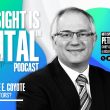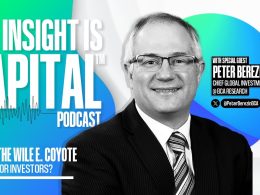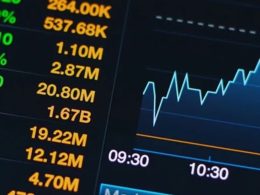by Liz Ann Sonders, Jeffey Kleintop, Kathy Jones, and Kevin Gordon, Randy Frederick, Charles Schwab & Company Ltd.
U.S. stocks and economy: Dodging false signals
Bulls may also have felt those payroll gains more than outweighed other deteriorating trends in the economy. However, growing payrolls and recessions aren’t mutually exclusive. There is historical precedent—like in the early 1970s—for continued job growth well after the start of a recession.
Meanwhile, leading economic indicators aren't suggesting a strong backdrop for the labor market. As shown in the chart below, The Conference Board's Leading Economic Index (LEI) has fallen by nearly 2% over the past six months. Excluding the reaction to the pandemic, LEI hasn’t stumbled like this since August 2009. Such a decline is also consistent with prior periods when the economy was entering a recession.
Leading economic indicators are turning

Source: Charles Schwab, Bloomberg. Nonfarm payrolls as of 7/31/2022. LEI as of 6/30/2022.
Y-axis is truncated at 3,000 and -3,000 to account for pandemic-related distortions.
It’s possible the stock market isn’t taking full account of the weakness in the labor market and broader economy. As shown below, Russell 3000 index constituents with the weakest earnings growth (i.e., negative or no earnings) have decisively outperformed their higher-quality peers since the most recent trough in mid-June. With the Fed aggressively hiking rates and the economy having slowed considerably, we don't think such speculative segments of the market will continue to outperform.
Weak profits, strong performance

Source: Charles Schwab, Bloomberg, as of 8/5/2022.
Past performance is no guarantee of future results.
Stretched sentiment—at either extreme—is never itself sufficient evidence that stocks are ripe for a reversal. Some investors may be waiting for a negative catalyst to come along and send stocks lower, but we think the market will face more pressure from slower growth and restrictive Fed policy.
Sentiment turns frothier

Source: Charles Schwab, SentimenTrader, as of 8/2/2022.
SentimenTrader's Smart Money Confidence and Dumb Money Confidence Indexes are used to see what the "good" market timers are doing with their money compared to what the "bad" market timers are doing and are presented on a scale of 0% to 100%. When the Smart Money Confidence Index is at 100%, it means that those most correct on market direction are 100% confident of a rising market. When it is at 0%, it means good market timers are 0% confident in a rally. The Dumb Money Confidence Index works in the opposite manner.
Fixed income: All roads lead to yield curve inversion
With the annual inflation rate still at 8.5% and wage growth running at more than 5%, more rate hikes are likely on the horizon. The current market pricing suggests investors expect a peak in the federal funds rate of 3.6% in the first quarter of 2023, followed by a series of rate cuts that should bring the rate down to 3% by early 2024.
Markets are pricing in a peak by early next year

Source: Bloomberg.
Market estimate of the Fed funds using Fed Funds Futures Implied Rate (FFM2 COMB Comdty). As of 8/5/2022 For illustrative purposes only. Please read the Risk Disclosure for Futures and Options prior to trading futures products. Futures accounts are not protected by SIPC.
Overall CPI growth has reached 8.5% year over year

Source: U.S. Bureau of Labor Statistics. As of 7/31/2022.
Consumer Price Index for All Urban Consumers: All Items Less Food & Energy (CPI XYOY Index) and Consumer Price Index for All Urban Consumers: All Items (CPI YOY Index), Percent Change from Year Ago, Monthly, Seasonally Adjusted. Note: The Consumer Price Index measures changes in the price level of consumer goods and services purchased by households. Core inflation (Core CPI) is a measure of inflation which excludes certain items that face volatile price movements, notably food and energy.
One of the outgrowths of rapid Fed tightening is an inverted yield curve, where short-term interest rates are higher than longer-term rates. By boosting short-term borrowing costs and reducing the liquidity available to the financial system, the Fed's actions should slow economic growth and cool inflation down the road. In most tightening cycles, long-term yields lag the rise in short-term rates because bond yields reflect expectations about future growth and inflation, as well as the future path of the federal funds rate.
The inversion of the yield curve in this cycle is one of the steepest in modern history. The yield spread between two-year and 10-year Treasuries, at about negative 40 basis points, has only been this low a few times in the past 40 years. However, there is no theoretical limit to how far it can fall. In the early 1980s, the spread was more than 200 basis points.
The yield curve between short- and longer-term Treasuries is inverted

Source: Bloomberg. Daily data as of 8/8/2022.
Note: The rates are comprised of Market Matrix U.S. Generic spread rates (USYC2Y10)This spread is a calculated Bloomberg yield spread that replicates selling the current 2 year U.S. Treasury Note and buying the current 10 year U.S. Treasury Note, then factoring the differences by 100.
Global stocks and economy: Earnings recession?
Overseas economic growth has been stronger than expected

Source: Charles Schwab, Bloomberg data as of 8/5/2022.
Forecasts contained herein are for illustrative purposes only, may be based upon proprietary research and are developed through analysis of historical public data. 2Q22 GDP for Japan is the Bloomberg consensus forecast (preliminary GDP data to be released on 8/14).
An inverted U.S. Treasury yield curve hasn’t just been a negative sign for the U.S. economy—historically, it has also augured global recessions. There are about 90 different U.S. Treasury yield spreads that compare every shorter maturity to longer active maturities. Rather than picking just one spread, like the two-year/10-year, looking at all of the spreads can tell us how much of the whole curve is inverted. As of early August, more than half of all yield curves had inverted.
Percentage of U.S. yield curves inverted is now over 50%

Source: Charles Schwab, Macrobond, US Department of Treasury data as of 8/8/2022.
U.S. Breakeven 10 Year (USGGBE10 Index) and U.S. Breakeven 5 Year (USGGBE05 Index). Daily data as of 7/13/2022 The breakeven rate is the difference between the TIPS rate and the comparable-maturity Treasury rate, and is used as a gauge for what market participants believe inflation will be five or 10 years in the future.
Analysts expect double-digit earnings growth

Source: Charles Schwab, MSCI, FactSet data as of 8/5/2022.
Forecasts contained herein are for illustrative purposes only, may be based upon proprietary research and are developed through analysis of historical public data.
Copyright © Charles Schwab & Company Ltd.















